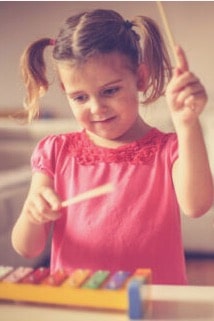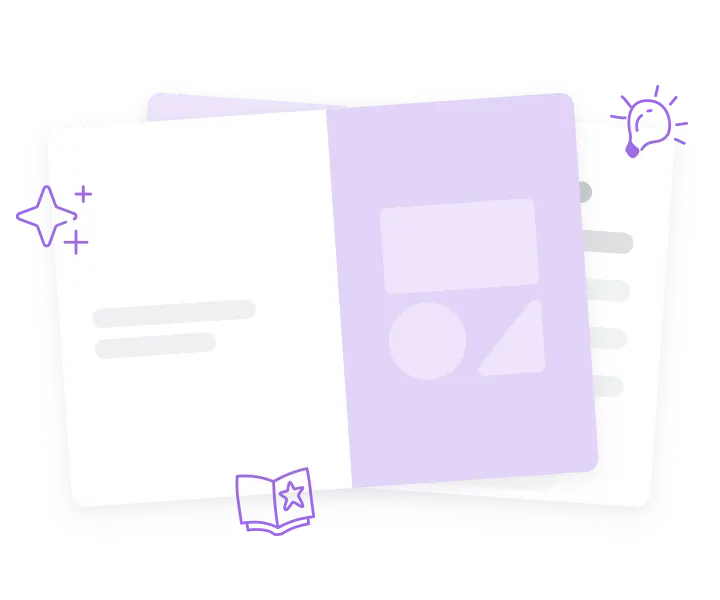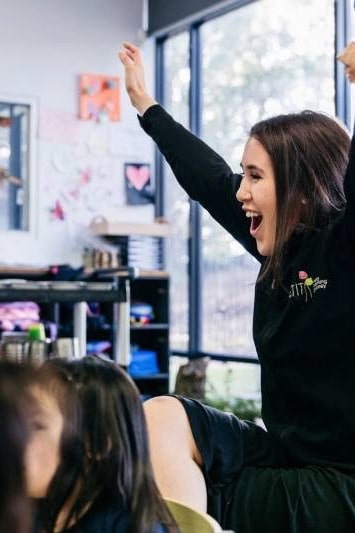settings
children
With Famly since
Incorporating music and movement into your classroom is easy. Most music activities for preschoolers just need three things: a playlist, lots of floor space and speakers, or something to play music out loud with. That's it!
Music is a great way to support language, communication, literacy, motor skills and physical development. Plus, as the children get up and move, they can become more confident and more aware of being in their own skin. It also allows them to practice both their leadership skills, and their social emotional development.
Preschool music and movement activity ideas
1. Musical statues, a.k.a Freeze dance!

This one will help children develop spatial intelligence, a sense of rhythm, and the ability to move on the beat, all while having tons of fun.
What you need:
- Speakers
- A playlist with fun songs from a variety of genres
- Plenty of space to move around
How to do it: Have the children help you clear out plenty of space, then explain to them that they should dance freely while the music is playing. The trick is, they must stop - or freeze! - when the music stops and stay completely still until it starts again. Encourage the children to change their dancing style to match the music.
Source: Kid Activities
2. Dancing with props

Props always add excitement to any activity. Children will have to learn to share (when someone else picks up the prop they wanted), learn to move quickly, and of course have fun moving about and expressing themselves.
What you need:
- A music player
- A playlist with songs from a variety of genres
- Plenty of space
- A table filled with props (scarves, hats, ribbons, plastic flowers, toys, musical instruments, etc.)
How to do it: Begin by designating a play area large enough for children to dance.Set up a music player and spread your props out on a table. Explain to the children that when you start playing music, they should select a prop from the table and begin dancing to the music. Whenever the music stops, they are to return the prop to the table and choose another one.
Source: Icebreaker Ideas
The big ideas

3. Exploring musical moods

Introduce toddlers to the connection between music and emotion with this imaginative game. Help them develop lateral thinking abilities, empathy, and communication skills.
What you need:
- A music player
- A playlist with songs from a variety of artists, genres, and time periods
- Plenty of space
How to do it: Take some time to develop a varied playlist filled with music that conveys different moods. Explain to the children that the way they feel can often be expressed in music. Then, play them different songs and ask them how the music makes them feel. Take this exercise a step further by having the children express the emotions they’re feeling through dance and movement.
Source: Scary Mommy
4. Follow the (musical) leader

Encourage the development of social and communication skills with this fun musical variation on follow the leader.
What you need:
- A music player
- Some fun music
- Plenty of space
How to do it: Have the children take turns at being the leader who creates all the dance movements and sounds. Encourage children to imitate and follow the leader!
Source: Very Well Family
5. Draw what you hear

Encourage creativity and independent thinking with this fun game that allows children to transform the sounds they’re hearing into shapes and patterns.
What you need:
- A playlist of songs from a variety of artists, genres, and time periods
- A music player
- Paper
- Crayons, finger paints, or markers
How to do it: Play a variety of songs for the children and have them draw what they hear. You can use this as an opportunity to introduce musical and emotional vocabulary. Have the children describe what they are drawing, and why that image came to mind from the music.
Source: Child Fun
6. Rhythm sticks

Rhythm sticks are quick and easy to pick up, making them an excellent first instrument for toddlers. Teach them rhythm, beat-matching, and spatial awareness as you add rhythm sticks to their favorite songs and nursery rhymes.
What you need:
- Rhythm sticks (two for each child)
- Songs and nursery rhymes to play along to
How to do it: Start by demonstrating how to use the sticks. When the music starts, have them pick up their sticks and clap them together to the beat. Once they have the hang of it, they can start singing along too.
Source: Teaching 2 and 3 Year Olds

7. The Hokey Pokey

The Hokey-Pokey is more than just a fun, energizing game. It helps children develop listening skills, coordination, and balance while teaching them different body parts and helping them tell their left from their right.
What you need:
- Plenty of space
- A music player
- A recording of the Hokey Pokey
How to do it: Play the song and show the children how to sing along and what body movements to do to match each verse. Mix up the body parts that you sing to teach them to listen closely and pay close attention.
Source: Petit Journey
8. Fun with personalized drums

Help children develop a sense of respect for musical instruments by creating their very own drum. Then teach them rhythm and listening skills through fun drumming patterns.
What you need:
- Drums (these can be empty containers, cans, boxes, cookie tins, and the like)
- Decorations like stickers, glitters, and pom poms for the drums
How to do it: Set up a drum creation station with a range of decoration options, and help the little ones decorate their drums. Once they are decorated, let the music-making begin! Teach them different rhythms, starting with short, simple patterns and gradually increasing the length and difficulty of the patterns as the children learn and progress.
Source: Music Together
9. Dance like an animal

Get toddlers exploring their creative side and developing their timing and coordination skills with this animal-inspired musical game.
What you need:
- A music player
- Pictures of animals
- Plenty of space
How to do it: Collect all your animal pictures and then play some music. Call out the name of an animal and hold up the picture so they can get a feel for how it looks. Each time you call out a new animal, they must start dancing the way they think that animal might move. Encourage them to make noises and interact with each other while in character as each creature.
Source: Mom Junction
10. A twist on musical chairs - musical letters
Practice letters and literacy with musical letters. It takes the classic “Freeze” activity to a new level!
What you need:
- Large alphabet letters to put on the floor
- A playlist of songs
- Speakers
How to do it: Put the large letters on the floor. Start dancing as the music plays and once the music stops, each kid needs to hurry to stand on the closest letter. Then, each child is encouraged to say the name of the letter, and a word that starts with that letter. Start the music again, and repeat!
Source: Empowered Parents
Please note: here at Famly we love sharing creative activities for you to try with the children at your setting, but you know them best. Take the time to consider adaptions you might need to make so these activities are accessible and developmentally appropriate for the children you work with. Just as you ordinarily would, conduct risk assessments for your children and your setting before undertaking new activities, and ensure you and your staff are following your own health and safety guidelines.
Free downloadable Early Childhood resources
Explore our library of longer-form books, guides and editable templates - all free to download.
Explore free resources









